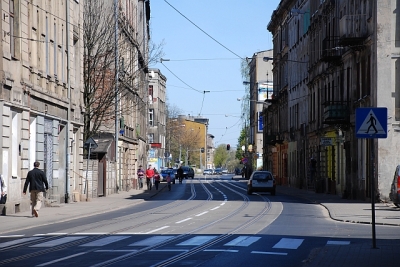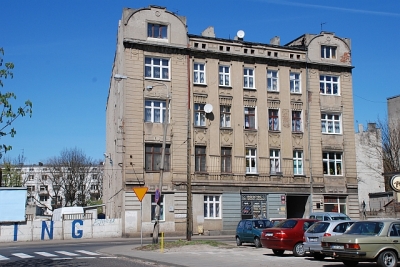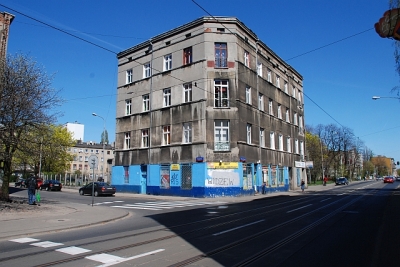
Brzezinska Street started at Plac Koscielny at Lagiewnicka Street, and ended at the eastern border of the ghetto. Several important institutions were located in the neighborhood of St. Mary's Assumptions Church.
 At 10 Brzezinska St. stood a printing house, which Rumkowski supervised. Posters, playbills and a variety of ghetto announcements were edited and printed here. It was a way of maintaining contact with the ghetto population. The announcements were published in Polish, Yiddish, and. German. These were both official Nazi orders and internal announcements Rumkowski issued. This printing house also at produced calendars, food coupons, tobacco coupons, etc. The same building housed a signboard workshop and a milk kitchen for babies.
At 10 Brzezinska St. stood a printing house, which Rumkowski supervised. Posters, playbills and a variety of ghetto announcements were edited and printed here. It was a way of maintaining contact with the ghetto population. The announcements were published in Polish, Yiddish, and. German. These were both official Nazi orders and internal announcements Rumkowski issued. This printing house also at produced calendars, food coupons, tobacco coupons, etc. The same building housed a signboard workshop and a milk kitchen for babies.
 Nearby, at 24 Brzezinska St. was the Eldorado for smokers, as ghetto chronicler Oskar Singer called it. The ghetto cigarettes, traded in secret, were at first made of Yugoslavian tobacco with an added dose of French Gauloise brand and various herbs picked and dried in the ghetto. In the winter of 1941, Rumkowski decided to monopolize the tobacco business. The Tobacco Department was located in an old pharmacy in a tenement building at Mlynarska Street. The cigarettes were imported from Croatia. A smoker's card entitled a person to buy an allotted quantity.
Nearby, at 24 Brzezinska St. was the Eldorado for smokers, as ghetto chronicler Oskar Singer called it. The ghetto cigarettes, traded in secret, were at first made of Yugoslavian tobacco with an added dose of French Gauloise brand and various herbs picked and dried in the ghetto. In the winter of 1941, Rumkowski decided to monopolize the tobacco business. The Tobacco Department was located in an old pharmacy in a tenement building at Mlynarska Street. The cigarettes were imported from Croatia. A smoker's card entitled a person to buy an allotted quantity.
At 40 Brzezinska St., the Meat Headquarters and the Sausage Factory were located. Over at 74 Brzezinska St. was the so-called Orthodox Canteen for Jews that attempted to maintain a kosher diet as dictated by the rules of kashrut.
Many structures on the even-numbered side of the street still exist; the majority of the buildings on the other side of Brzezinska were torn down during the war. A part of the area is now occupied by new apartment blocks. The stretch between Franciszkanska and Zrodlowa streets, where cropland and vegetable gardens were located, still remains abandoned.
Elsewhere, a sorting plant for waste materials held the site at 11 Brzezinska St.; a prayer house occupied 23 Brzezinska St. The building at 47 Brzezinska St. housed a large factory that produced civilian and military caps. The caps and hats department was established in March 1941; within a month, several dozen workers had made more than 15,000 caps, using 45 machines. Later, the factory took on several hundred laborers that not only produced new caps, but also mended old ones.
A shoemakers' department, which manufactured military boots, was located further down at 82/84 Brzezinska St. The straw shoes department took over the premises of the Gypsy Camp, which was liquidated in January 1942.
This unit produced straw shoes for the German soldiers on the eastern front to help protect them from the severe winters. Immediately behind the straw shoes department, where the ghetto border stood, there was the Recycled Materials Department, where all possible waste materials could be re-used. This was the last building of the ghetto, and a German guardhouse was positioned next to it [see: The Gypsy Camp]. In 1942, a chunk of space made up of sections of Brzezinska, Smugowa, Franciszkanska and Oblegorska streets was excluded from the ghetto. The area was cleansed of its inhabitants. Soon, a transfer tram ran along Brzezinska and Franciszkanska streets, cutting through the ghetto and connecting the city with the Christian cemeteries in the Doly area. The tram cars were closed and sealed before entering the ghetto; no one could get in or off [see: The trams in the ghetto].
The Printing House supervised by the Eldest of the Jews has published two kinds of calendars: a table calendar divided into weeks and a large calendar. Printed are 1,800 copies of the first, and 4,000 copies of the second variety. The table calendar, consisting of an individual page for each week, is published in German and Yiddish. It is decorated with an original photograph of the Chairman. The calendars were published only for the offices, divisions, departments and institutions supervised by the Eldest of the Jews. A special circular, sent to the divisions a day before the distribution of the calendar is to mailed, warned that the calendars constitute official inventory and can only be used for office purposes.
The Chronicle of the Lodz Ghetto, January 6, Vol. 1, p. 375.
With regard to the Easter approaching, a network of matzoh bakeries is gradually opened. Last week already 10 such bakeries functioned, and this week their number doubled. [...] 2,000 people are employed at the matzoh baking. The daily output is 12,000 kgs. Before the work started, in the prayer house at 23 Brzezinska Street, the bakery owners and their deputies had sworn not to commit any abuses. The matzoh is packed in 2,5 kgs packages and marked with control numbers and bakery address.
The Chronicle of the L6d:i. Ghetto, March 26, 1941, Vol. 1, p. 97.
As I have learned from private sources, 2,000 employees of the straw shoes department were dismissed. As for the reasons, I have been given two contradictory versions. According to the first one, a work race was taking place in that department last week. The employees were supposed to plait at least 15 meters of straw, or to sew at least three pairs of shoes a day. Last week, however, reportedly because of lack of straw, the work pace completely slowed down.
According to the second version, these days a German committee stayed in that department and demanded that a daily output per worker be at least six pairs.
The objections of the management, which suspected that it will exceed the possibilities of many employees, were answered shortly: Dismiss those who are not fit and employ suitable ones.
The Chronicle of the Lodz Ghetto, June 28, 1942, Vol. 2, p. 95.
Huge orders for straw shoes for the army requires the department to enlarge its crew. The Labor Department delegates workers from other units to this work.
This concerns people who have less work and are of appropriate age. The crew is to number about 6,000 people in total.
The Chronicle of the Lodz Ghetto, October 12-13, 1942, Vol. 2, p. 295.

 Home
Home
